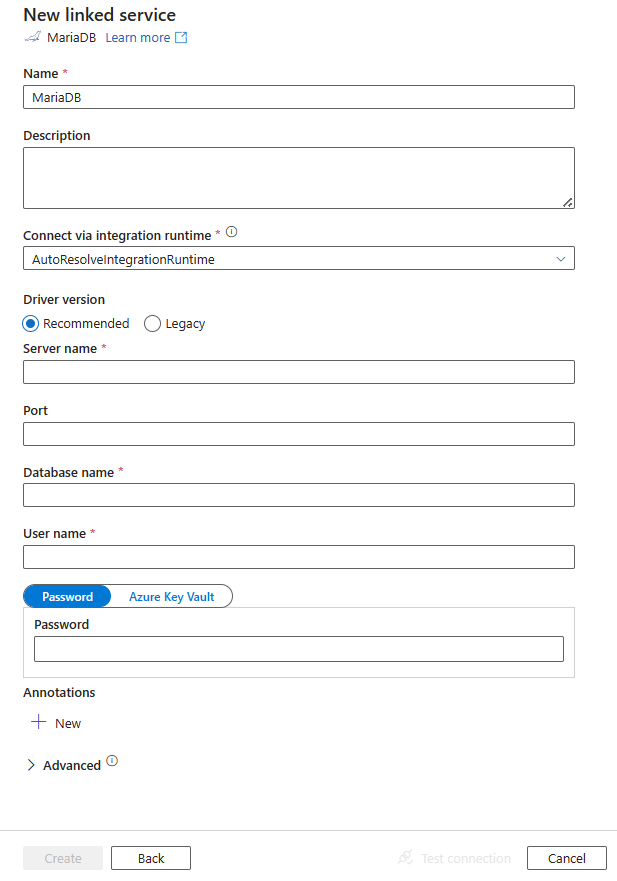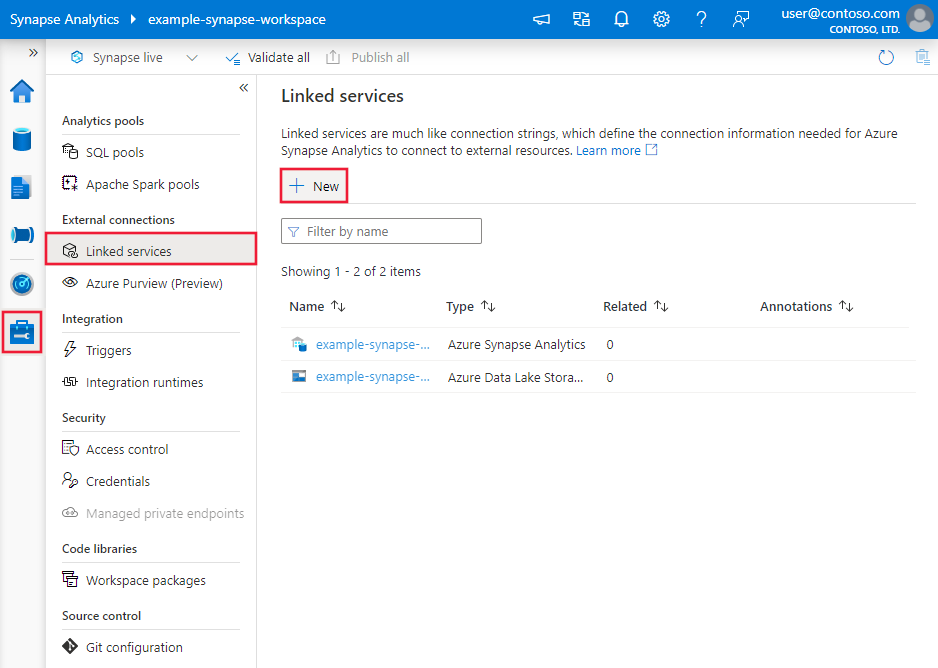Copy data from MariaDB using Azure Data Factory or Synapse Analytics
APPLIES TO:  Azure Data Factory
Azure Data Factory  Azure Synapse Analytics
Azure Synapse Analytics
Tip
Try out Data Factory in Microsoft Fabric, an all-in-one analytics solution for enterprises. Microsoft Fabric covers everything from data movement to data science, real-time analytics, business intelligence, and reporting. Learn how to start a new trial for free!
This article outlines how to use the Copy Activity in an Azure Data Factory or Synapse Analytics pipeline to copy data from MariaDB. It builds on the copy activity overview article that presents a general overview of copy activity.
Supported capabilities
This MariaDB connector is supported for the following capabilities:
| Supported capabilities | IR |
|---|---|
| Copy activity (source/-) | ① ② |
| Lookup activity | ① ② |
① Azure integration runtime ② Self-hosted integration runtime
For a list of data stores that are supported as sources/sinks by the copy activity, see the Supported data stores table.
The service provides a built-in driver to enable connectivity, therefore you don't need to manually install any driver using this connector.
This connector currently supports MariaDB of version 10.x, 11.x under the recommended new driver version v2 and 10.0 to 10.5 for the legacy driver version.
Prerequisites
If your data store is located inside an on-premises network, an Azure virtual network, or Amazon Virtual Private Cloud, you need to configure a self-hosted integration runtime to connect to it.
If your data store is a managed cloud data service, you can use the Azure Integration Runtime. If the access is restricted to IPs that are approved in the firewall rules, you can add Azure Integration Runtime IPs to the allow list.
You can also use the managed virtual network integration runtime feature in Azure Data Factory to access the on-premises network without installing and configuring a self-hosted integration runtime.
For more information about the network security mechanisms and options supported by Data Factory, see Data access strategies.
Getting started
To perform the Copy activity with a pipeline, you can use one of the following tools or SDKs:
- The Copy Data tool
- The Azure portal
- The .NET SDK
- The Python SDK
- Azure PowerShell
- The REST API
- The Azure Resource Manager template
Create a linked service to MariaDB using UI
Use the following steps to create a linked service to MariaDB in the Azure portal UI.
Browse to the Manage tab in your Azure Data Factory or Synapse workspace and select Linked Services, then click New:
Search for Maria and select the MariaDB connector.

Configure the service details, test the connection, and create the new linked service.

Connector configuration details
The following sections provide details about properties that are used to define Data Factory entities specific to MariaDB connector.
Linked service properties
If you use the recommended driver version, the following properties are supported for MariaDB linked service:
| Property | Description | Required |
|---|---|---|
| type | The type property must be set to: MariaDB | Yes |
| driverVersion | The driver version when you select the recommended driver version. The value is v2. | Yes |
| server | The name of your MariaDB Server. | Yes |
| port | The port number to connect to the MariaDB server. | No |
| database | Your MariaDB database name. | Yes |
| username | Your user name. | Yes |
| password | The password for the user name. Mark this field as SecureString to store it securely. Or, you can reference a secret stored in Azure Key Vault. | Yes |
| connectVia | The Integration Runtime to be used to connect to the data store. Learn more from Prerequisites section. If not specified, it uses the default Azure Integration Runtime. | No |
Example:
{
"name": "MariaDBLinkedService",
"properties": {
"type": "MariaDB",
"typeProperties": {
"server": "<server>",
"port": "<port>",
"database": "<database>",
"username": "<username>",
"password": {
"type": "SecureString",
"value": "<password>"
},
"driverVersion": "v2"
},
"connectVia": {
"referenceName": "<name of Integration Runtime>",
"type": "IntegrationRuntimeReference"
}
}
}
Example: store password in Azure Key Vault
{
"name": "MariaDBLinkedService",
"properties": {
"type": "MariaDB",
"typeProperties": {
"server": "<server>",
"port": "<port>",
"database": "<database>",
"username": "<username>",
"password": {
"type": "AzureKeyVaultSecret",
"store": {
"referenceName": "<Azure Key Vault linked service name>",
"type": "LinkedServiceReference"
},
"secretName": "<secretName>"
},
"driverVersion": "v2"
},
"connectVia": {
"referenceName": "<name of Integration Runtime>",
"type": "IntegrationRuntimeReference"
}
}
}
If you use the legacy driver version, the following properties are supported:
| Property | Description | Required |
|---|---|---|
| type | The type property must be set to: MariaDB | Yes |
| connectionString | An ODBC connection string to connect to MariaDB. You can also put password in Azure Key Vault and pull the pwd configuration out of the connection string. Refer to the following samples and Store credentials in Azure Key Vault article with more details. |
Yes |
| connectVia | The Integration Runtime to be used to connect to the data store. Learn more from Prerequisites section. If not specified, it uses the default Azure Integration Runtime. | No |
Example:
{
"name": "MariaDBLinkedService",
"properties": {
"type": "MariaDB",
"typeProperties": {
"connectionString": "Server=<host>;Port=<port>;Database=<database>;UID=<user name>;PWD=<password>"
},
"connectVia": {
"referenceName": "<name of Integration Runtime>",
"type": "IntegrationRuntimeReference"
}
}
}
Dataset properties
For a full list of sections and properties available for defining datasets, see the datasets article. This section provides a list of properties supported by MariaDB dataset.
To copy data from MariaDB, set the type property of the dataset to MariaDBTable. There is no additional type-specific property in this type of dataset.
Example
{
"name": "MariaDBDataset",
"properties": {
"type": "MariaDBTable",
"typeProperties": {},
"schema": [],
"linkedServiceName": {
"referenceName": "<MariaDB linked service name>",
"type": "LinkedServiceReference"
}
}
}
Copy activity properties
For a full list of sections and properties available for defining activities, see the Pipelines article. This section provides a list of properties supported by MariaDB source.
MariaDB as source
To copy data from MariaDB, set the source type in the copy activity to MariaDBSource. The following properties are supported in the copy activity source section:
| Property | Description | Required |
|---|---|---|
| type | The type property of the copy activity source must be set to: MariaDBSource | Yes |
| query | Use the custom SQL query to read data. For example: "SELECT * FROM MyTable". |
No (if "tableName" in dataset is specified) |
Example:
"activities":[
{
"name": "CopyFromMariaDB",
"type": "Copy",
"inputs": [
{
"referenceName": "<MariaDB input dataset name>",
"type": "DatasetReference"
}
],
"outputs": [
{
"referenceName": "<output dataset name>",
"type": "DatasetReference"
}
],
"typeProperties": {
"source": {
"type": "MariaDBSource",
"query": "SELECT * FROM MyTable"
},
"sink": {
"type": "<sink type>"
}
}
}
]
Data type mapping for MariaDB
When copying data from MariaDB, the following mappings are used from MariaDB data types to interim data types used by the service internally. See Schema and data type mappings to learn about how copy activity maps the source schema and data type to the sink.
| MariaDB data type | Interim service data type | Interim service data type (for the legacy driver version) |
|---|---|---|
bigint |
Int64 |
Int64 |
bigint unsigned |
Decimal |
Decimal |
bit(1) |
UInt64 |
Boolean |
bit(M), M>1 |
UInt64 |
Byte[] |
blob |
Byte[] |
Byte[] |
bool |
Boolean (If TreatTinyAsBoolean=false, it is mapped as SByte. TreatTinyAsBoolean is true by default ) |
Int16 |
char |
String |
String |
date |
Datetime |
Datetime |
datetime |
Datetime |
Datetime |
decimal |
Decimal |
Decimal, String |
double |
Double |
Double |
double precision |
Double |
Double |
enum |
String |
String |
float |
Single |
Single |
int |
Int32 |
Int32 |
int unsigned |
Int64 |
Int64 |
integer |
Int32 |
Int32 |
integer unsigned |
Int64 |
Int64 |
JSON |
String |
- |
long varbinary |
Byte[] |
Byte[] |
long varchar |
String |
String |
longblob |
Byte[] |
Byte[] |
longtext |
String |
String |
mediumblob |
Byte[] |
Byte[] |
mediumint |
Int32 |
Int32 |
mediumint unsigned |
Int64 |
Int64 |
mediumtext |
String |
String |
numeric |
Decimal |
Decimal |
real |
Double |
Double |
set |
String |
String |
smallint |
Int16 |
Int16 |
smallint unsigned |
Int32 |
Int32 |
text |
String |
String |
time |
TimeSpan |
TimeSpan |
timestamp |
Datetime |
Datetime |
tinyblob |
Byte[] |
Byte[] |
tinyint |
SByte |
Int16 |
tinyint unsigned |
Int16 |
Int16 |
tinytext |
String |
String |
varchar |
String |
String |
year |
Int |
Int |
Lookup activity properties
To learn details about the properties, check Lookup activity.
Upgrade the MariaDB driver version
Here are steps that help you upgrade your MariaDB driver version:
In Edit linked service page, select Recommended under Driver version and configure the linked service by referring to Linked service properties.
The data type mapping for the latest MariaDB linked service is different from that for the legacy version. To learn the latest data type mapping, see Data type mapping for MariaDB.
The latest driver version v2 supports more MariaDB versions. For more information, see Supported capabilities.
Differences between MariaDB using the recommended driver version and using the legacy driver version
The table below shows the data type mapping differences between MariaDB connector using the recommended driver version and using the legacy driver version.
| MariaDB data type | Interim service data type (using the recommended driver version) | Interim service data type (using the legacy driver version) |
|---|---|---|
| bit(1) | UInt64 | Boolean |
| bit(M), M>1 | UInt64 | Byte[] |
| bool | Boolean | Int16 |
| JSON | String | Byte[] |
Related content
For a list of data stores supported as sources and sinks by the copy activity, see supported data stores.
Feedback
Coming soon: Throughout 2024 we will be phasing out GitHub Issues as the feedback mechanism for content and replacing it with a new feedback system. For more information see: https://aka.ms/ContentUserFeedback.
Submit and view feedback for

